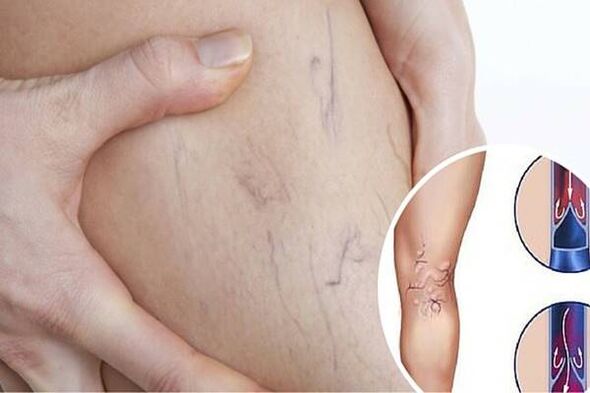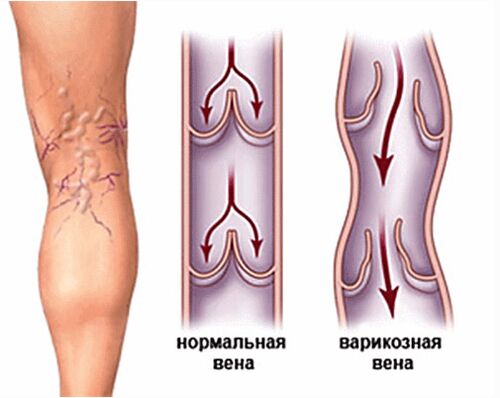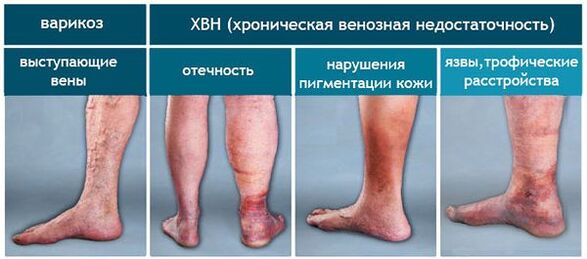According to statistics, about 83% of the population faces a disease as varicose veins of the lower ends.Therefore, it is important to know how varicose veins are varicose veins in the early phase.This will timely identify the disease and prevent the development of possible complications.

Varicose veins
Veins disease, which is accompanied by its expansion, the destruction of the valve apparatus can affect the various organs of the body.Therefore, the classification of this pathology is based on the site of its location.
According to the International Classification of Diseases of the 10th Review, these types of disease are distinguished:
- Varicose veins of the blood circulation system.
- Expansion of the veins of the digestive tract.
- The accumulation of numerous pathological clots in one place.
- Varicherosis of lymph nodes and vessels that are not systematized in other sections.
- Varicosa expansion of the lower ends.
The use of ICD 10 in medical practice allows a phlebologist to make proper diagnosis and differentiation of varicose veins.
In turn, varicose veins at the lower ends, depending on the stage of the course, are classified in the disease with:
- Ulcerative lesions.
- Progressive inflammatory processes.
- Ulcer and inflammation.
- Varicose veins of the legs or other part with damage to the skin.
- Lack of vein deformation with ulcers, inflammatory processes.
Taking into account the main places of location of pathological changes, varicose veins are distinguished:
- Superficial veins.
- Deep veins.
- Reticular.
The extensive classification of varicose veins is determined by a wide variety of options for the course of the disease.In pathology differentiation, modern doctors use not only ICD-10, but also the classification of disease in shape.
In medical practice, these forms of varicose veins are distinguished:
- Partial damage to subcutaneous and intradermal -type blood vessels without reverse output.
- Segmental defeat with a reverse exit of blood in all veins.
- An extensive defeat by the discharge of pathological etiology in subcutaneous veins.
- A common injury of veins with an abnormal discharge through deep veins.
The deformation and vein dysfunction of the blood flow can be of various types.Only a doctor is able to diagnose and correctly establish a type of varicose veins based on the results of a complex examination.

The degree of varicose veins
Depending on the disease progression process, varicose veins have 4 stages of development.Each is characterized by certain symptoms.
- In the first stage, gravity in the legs and pain of a painful nature are felt.Vascular stars, tied veins and swelling are visualized.They are possible involuntary spasms of the calf muscles and the manifestation of burning in the foot area.It is characterized by the absence of stagnation in the bloodstream.
- The second degree of varicose veins is accompanied by oxygen hunger from the venous system.It is characterized by a rapid increase in the size and number of vascular and stars.This damage clearly expressed limits, which contributes to its brightest manifestation.Perhaps their grouping in the same area of defeat is small behind the area.In this case, the pain and swelling of the soft tissues are improved.
- With the third degree of varicose veins, trophic lesions of the medial surface of the leg are formed.It is characterized by the appearance of brown areas on the skin, which, with the progression of the disease, are covered with dry crust and cracking.Against your history, dermatitis is possible.The presence of great edema becomes dangerous.There is a lot of fatigue and pain.
- The fourth degree is complications of the disease.They may appear in the form of inflammatory processes, trophic ulcers on the vein walls.Bleeding is possible with mechanical damage to seals.This degree is dangerous with the possibility of developing venous insufficiency, which can subsequently acquire a chronic form.
In the third and fourth stage, the patient begins to feel intense pain of a different nature, both in the muscles and in venous trunks.It is extremely rare, there may be a break from us, accompanied by an insignificant blood loss.Most of the time, this sign is manifested at night.If, with varicose veins, hyperthermia and increased weakness have appeared, this directly indicates the appearance of complications of the disease.
Varicherosis itself is not a dangerous disease that is not subject to therapy.But it is worth noting that this pathology does not continue on its own and is progressing quickly.The identification of first degree varicose veins significantly increases the terms of rapid and successful recovery.The varicose veins of fourth degree are dangerous to body and human life.

Varicose veins of the lower ends
Varicose veins are characterized by various stages of pathology.Each determines the prevalence of the disease and has certain characteristics.There are many classifications of varicose veins, each with its own symptoms and therapy.Above all, in professional practice, modern doctors use the classification of varicose veins according to the degree of change in blood flow in body vessels.
The following stages of the disease are distinguished:
- It is characterized by the presence of cosmetic manifestation problems.There are no symptoms of thrombosis, but when examining the patient, signs of the early stage of varicose veins are found in the legs.Depending on the etiology of the pathology, the compensation stage of varicose veins without proper treatment throughout the year can turn into second degree varicose veins.
- Blood vessels are subject to deformation and are clearly manifested on the surface of the legs.The varicosis of this stage is accompanied by the pain and swelling of the lower ends.There is a sense of gravity, the feeling of bursting and significantly increases the sensitivity of the skin.Swelling in the legs intensifies at night, and the next morning disappears.
- Visual signs of pathologists increase significantly.Networks and us venous do not only become only in the area, but also in volumes.An intensive sensation of itching appears.The surface of the skin acquires a dark tone, is dry and shiny.At this stage, there is a small bleeding, which causes hemosiderin deposition, leading to skin hyperpigmentation in the affected areas.
The early stage of varicose veins for each organism proceeds differently.The intensity of the manifestation of its symptoms and the duration of this period is individual and depends on many factors.Therefore, with the manifestation of the minor signs of pathology, you should immediately seek qualified medical assistance.Opposite treatment will prevent the development of more serious internships of varicose veins.
The early stage of the varicose veins in the legs: treatment of pathology
With varicose veins, the effectiveness of the therapeutic course depends directly on the timely manifestation of the pathology.Qualified medical care at the early stage of disease development allows us to completely restore the integrity of the vascular wall and the functionality of the damaged veins.
The treatment of early stage veins is performed comprehensively and consists of:
- Complex use of medicines.For complex veins, oral intake of preparations for tablets is performed.The use of local drugs in the form of ointments and gels has a high therapeutic effect.
- Sclerotherapy.After the procedure, the mandatory use of a special compression mesh.The effectiveness of sclerotherapy explains its use in the compensation phase for varicose veins of the lower ends.
- Ozonotherapy.It refers to treatment, which acts as one of the components of the complex varicose vein therapy at the early stage.Such procedures increase oxygen cell nutrition and stimulate blood circulation through the veins.As a result, gluing the affected walls of the blood vessels.
Each of the therapy methods for varicose veins requires mandatory prescription and control.The self -mate of varicose veins is strictly prohibited.
Varicose veins at the lower ends of the initial degree are difficult to diagnose independently.Visual information about the internet contributes to visual familiarization with characteristic signs of pathology.


















